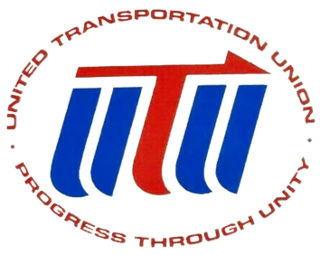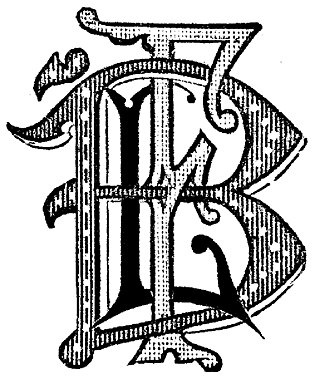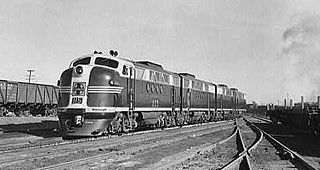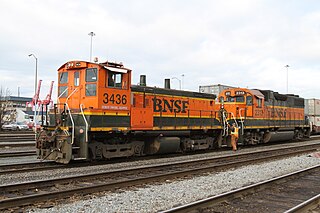
The United Transportation Union (UTU) was a broad-based, transportation labor union that represented about 70,000 active and retired railroad, bus, mass transit, and airline workers in the United States. The UTU was headquartered in Cleveland, Ohio. On August 11, 2014, it merged with the Sheet Metal Workers' International Association (SMWIA) to form the International Association of Sheet Metal, Air, Rail and Transportation Workers, known by the acronym SMART.

The American Railway Union (ARU) was briefly among the largest labor unions of its time and one of the first industrial unions in the United States. Launched at a meeting held in Chicago in February 1893, the ARU won an early victory in a strike on the Great Northern Railroad in the summer of 1894. This successful strike was followed by the bitter 1894 Pullman Strike in which government troops and the power of the judiciary were enlisted against the ARU, ending with the jailing of the union's leadership for six months in 1895 and effectively crushing the organization. The group's blacklisted and dispirited remnants finally disbanded the organization via amalgamation into the Social Democracy of America (SDA) at its founding convention in June 1897.

The Brotherhood of Locomotive Firemen and Enginemen was a North American railroad fraternal benefit society and trade union in the 19th and 20th centuries. The organization began in 1873 as the Brotherhood of Locomotive Firemen, a mutual benefit society for workers employed as firemen for steam locomotives, before expanding its name in 1907 in acknowledgement that many of its members had been promoted to the job of railroad engineer. Gradually taking on the functions of a trade union over time, in 1969 the B of LF&E merged with three other railway labor organizations to form the United Transportation Union.

The EMC-TA was a model of diesel locomotive produced for the Chicago, Rock Island and Pacific Railroad by the Electro-Motive Corporation in 1937. The original six Rock Island Rockets streamliners were three- or four-car stainless-steel semi-articulated trainsets built by Budd Company, powered by six identical locomotives, #601-606. The locomotives were classified as model TA—the T indicating Twelve hundred hp (890 kW), the A indicating an A unit. The Rock Island Line was EMC's only customer for the TA locomotive model.

The EMD FT is a 1,350-horsepower (1,010 kW) diesel-electric locomotive that was produced between March 1939 and November 1945, by General Motors' Electro-Motive Corporation (EMC), later known as GM Electro-Motive Division (EMD). The "F" stood for Fourteen Hundred (1400) horsepower and the "T" for Twin, as it came standard in a two-unit set. The design was developed from the TA model built for the C,RI&P in 1937, and was similar in cylinder count, axle count, length, and layout. All told 555 cab-equipped ”A” units were built, along with 541 cabless booster or ”B” units, for a grand total of 1,096 units. The locomotives were all sold to customers in the United States. It was the first model in EMD's very successful F-unit series of cab unit freight diesels and was the locomotive that convinced many U.S. railroads that the diesel-electric freight locomotive was the future. Many rail historians consider the FT one of the most important locomotive models of all time.

A fireman, stoker or watertender is a person whose occupation it is to tend the fire for the running of a boiler, heating a building, or powering a steam engine. Much of the job is hard physical labor, such as shoveling fuel, typically coal, into the boiler's firebox. On steam locomotives the title fireman is usually used, while on steamships and stationary steam engines, such as those driving saw mills, the title is usually stoker. The German word Heizer is equivalent and in Dutch the word stoker is mostly used too. The United States Navy referred to them as watertenders.

The Great Railroad Strike of 1922, or the Railway Shopmen's Strike, was a nationwide strike of railroad workers in the United States. Launched on July 1, 1922 by seven of the sixteen extant railroad labor organizations, the strike continued into August before collapsing. A sweeping judicial injunction by Judge James Herbert Wilkerson effectively ended the strike on September 1, 1922.

A train driver, engine driver, engineman or locomotive driver, commonly known as an engineer or railroad engineer in the United States and Canada, and also as a locomotive handler, locomotive engineer, locomotive operator, train operator, or motorman, is a person who operates a train, railcar, or other rail transport vehicle. The driver is in charge of and is responsible for the mechanical operation of the train, train speed, and all of the train handling. In American English, a hostler moves engines around rail yards, but does not take them out on the main line tracks; the British English equivalent is a shunter.

The Leader was a class of experimental 0-6-0+0-6-0T articulated steam locomotive, produced in the United Kingdom to the design of the innovative engineer Oliver Bulleid. The Leader was an attempt to extend the life of steam traction by eliminating many of the operational drawbacks associated with existing steam locomotives. It was intended as a replacement for the ageing fleet of M7 class tank engines still in operation on the Southern Railway (SR). Design work began in 1946 and development continued after the nationalisation of the railways in 1948, under the auspices of British Railways (BR).

A remote control locomotive is a railway locomotive that can be operated with a remote control. It differs from a conventional locomotive in that a remote control system has been installed in one or more locomotives within the consist, which uses either a mechanical or radio transmitter and receiver system. The locomotive is operated by a person not physically at the controls within the locomotive cab. They have been in use for many years in the railroad industry, including industrial applications such as bulk material load-out, manufacturing, process and industrial switching. The systems are designed to be fail-safe so that if communication is lost the locomotive is brought to a stop automatically.
The railroad brotherhoods are labor unions of railroad workers in the United States. They first appeared in 1863 and they are still active. Until recent years they were largely independent of each other and of the American Federation of Labor.

The Switchmen's Mutual Aid Association of North America (SMAA) was a 19th-century fraternal benefit society and trade union in the United States of America. Its members included the operators of railway track switches and those who coupled train cars in railway yards. Organized in 1886, the union came to its demise in July 1894 with rise of the American Railway Union and the smashing defeat it was delivered in the 1894 Pullman Strike. The organization was succeeded in October 1894 with the establishment of the Switchmen's Union of North America.
The International Association of Railway Employees (IARE) was a union for black railroad workers formed in 1934 at a time when the major railroad brotherhoods restricted membership to whites. Members included conductors, trainmen, engineers, shop mechanics, porters and maintenance-of-way employees. It joined the United Transportation Union in 1970.

The Burlington railroad strike of 1888 was a failed union strike which pitted the Brotherhood of Locomotive Engineers, the Brotherhood of Locomotive Firemen, and the Switchmen's Mutual Aid Association (SMAA) against the Chicago, Burlington and Quincy Railroad (CB&Q) its extensive trackage in the Midwestern United States. It was led by the skilled engineers and firemen, who demanded higher wages, seniority rights, and grievance procedures. It was fought bitterly by management, which rejected the very notion of collective bargaining. There was much less violence than the Great Railroad Strike of 1877, but after 10 months the very expensive company operation to permanently replace all the strikers was successful and the strike was a total defeat for them.
Tunstall v. Brotherhood of Locomotive Firemen and Enginemen, 323 U.S. 210 (1944), is a 1944 Supreme Court case. It involved a black man, Tom Tunstall, who was unfairly dismissed from his job because of his race.

The International Brotherhood of Stationary Firemen (IBSF) was an American trade union established in 1898 and affiliated with the American Federation of Labor. The union was established as a mechanism for advancing the collective interests of workers engaged in the operation of steam boilers. Originally limited to stationary firemen, in 1919 the AF of L expanded the organization's jurisdictional mandate to oilers and boiler room helpers, and the name was changed to International Brotherhood of Stationary Firemen and Oilers (IBSFO).
The International Association of Sheet Metal, Air, Rail, and Transportation Workers (SMART) is a North American labor union headquartered in Washington, D. C., was chartered by the AFL–CIO in 2013. The product of a merger between the Sheet Metal Workers’ International Association (SMWIA) and the United Transportation Union (UTU), SMART represents over 210,000 sheet metal workers, service technicians, bus operators, engineers, conductors, sign workers, welders, and production employees, among others, throughout the United States, Puerto Rico, and Canada. The Transportation Division represents employees on Class I railroad, Amtrak, and regional and short line railroads; bus and mass transit employees on some 45 transit systems; and airline pilots, flight attendants, dispatchers and other airport personnel. The Division's 500 local unions organize conductors, brakemen, switch men, ground service personnel, locomotive engineers, hostlers, and railroad yard masters, as well as bus drivers and mechanics.

Joshua A. Leach was an American locomotive worker and trade union functionary. He is best remembered as the founder of the Brotherhood of Locomotive Firemen in 1873 and head of that organization from 1873 to 1876.
The Georgia Railroad strike of 1909, also known as the Georgia race strike, was a labor strike that involved white firemen working for the Georgia Railroad that lasted from May 17 to May 29. White firemen, organized under the Brotherhood of Locomotive Firemen and Enginemen, resented the hiring of African American firemen by the railroad and accompanying policies regarding seniority. The labor dispute ended in Federal mediation under the terms of the Erdman Act, with the mediators deciding in favor of the railroad on all major issues.














